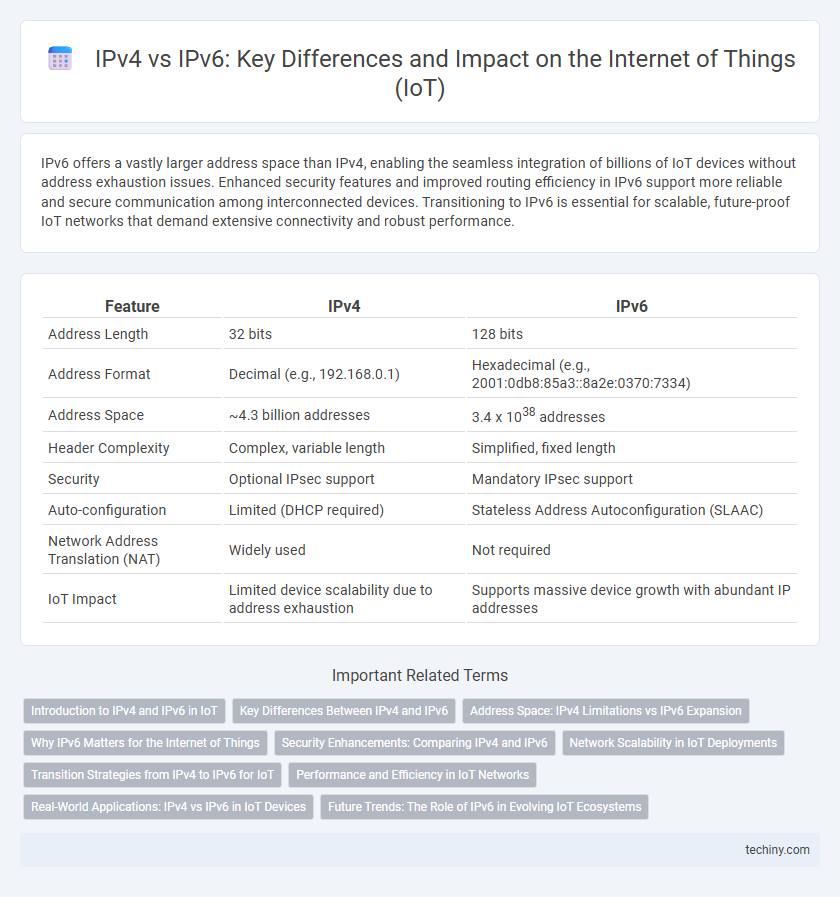IPv6 offers a vastly larger address space than IPv4, enabling the seamless integration of billions of IoT devices without address exhaustion issues. Enhanced security features and improved routing efficiency in IPv6 support more reliable and secure communication among interconnected devices. Transitioning to IPv6 is essential for scalable, future-proof IoT networks that demand extensive connectivity and robust performance.
Table of Comparison
| Feature | IPv4 | IPv6 |
|---|---|---|
| Address Length | 32 bits | 128 bits |
| Address Format | Decimal (e.g., 192.168.0.1) | Hexadecimal (e.g., 2001:0db8:85a3::8a2e:0370:7334) |
| Address Space | ~4.3 billion addresses | 3.4 x 1038 addresses |
| Header Complexity | Complex, variable length | Simplified, fixed length |
| Security | Optional IPsec support | Mandatory IPsec support |
| Auto-configuration | Limited (DHCP required) | Stateless Address Autoconfiguration (SLAAC) |
| Network Address Translation (NAT) | Widely used | Not required |
| IoT Impact | Limited device scalability due to address exhaustion | Supports massive device growth with abundant IP addresses |
Introduction to IPv4 and IPv6 in IoT
IPv4 uses a 32-bit addressing scheme allowing approximately 4.3 billion unique addresses, which is insufficient for the expanding number of IoT devices requiring global connectivity. IPv6, with its 128-bit addressing, offers a vastly larger address space of 3.4x10^38 addresses, enabling seamless scaling and direct device communication in IoT networks. Transitioning to IPv6 enhances device identification, improves security features, and supports efficient routing critical for the diverse and massive IoT ecosystem.
Key Differences Between IPv4 and IPv6
IPv4 uses a 32-bit address scheme allowing for approximately 4.3 billion unique addresses, while IPv6 employs a 128-bit address format, enabling an almost unlimited number of IP addresses critical for the expanding Internet of Things (IoT) landscape. IPv6 supports autoconfiguration and improved multicast routing, enhancing device connectivity and management in IoT ecosystems, whereas IPv4 relies on manual address configuration and limited multicast capabilities. Security is natively integrated into IPv6 through mandatory IPsec support, providing enhanced data protection over the IPv4 protocol, which treats IPsec as optional.
Address Space: IPv4 Limitations vs IPv6 Expansion
IPv4 supports approximately 4.3 billion unique addresses, which is increasingly insufficient for the rapid growth of Internet of Things (IoT) devices. IPv6 expands the address space to 340 undecillion unique addresses, effectively eliminating address exhaustion concerns and enabling vast IoT scalability. This expansive IPv6 addressing capability supports billions of interconnected devices with unique IPs, essential for seamless IoT network integration and management.
Why IPv6 Matters for the Internet of Things
IPv6 matters for the Internet of Things (IoT) because it provides an exponentially larger address space, enabling billions of connected devices to have unique IP addresses without network conflicts. Its improved security features, such as mandatory IPsec support, enhance data protection for smart devices in IoT ecosystems. Efficient routing and auto-configuration capabilities in IPv6 reduce network complexity, supporting seamless scalability and connectivity across diverse IoT applications.
Security Enhancements: Comparing IPv4 and IPv6
IPv6 offers significant security enhancements over IPv4 by integrating IPsec as a mandatory protocol, ensuring end-to-end encryption and authentication by default, whereas IPv4 treats IPsec as optional and less uniformly implemented. The expanded address space of IPv6 also reduces the need for Network Address Translation (NAT), minimizing attack surfaces associated with NAT traversal vulnerabilities common in IPv4 networks. Enhanced neighbor discovery protocols and improved packet processing in IPv6 help prevent spoofing and man-in-the-middle attacks, providing a more secure framework for Internet of Things (IoT) devices.
Network Scalability in IoT Deployments
IPv6 significantly enhances network scalability in IoT deployments by offering a vastly larger address space compared to IPv4, supporting trillions of unique device identifiers essential for massive IoT ecosystems. The 128-bit addressing scheme of IPv6 enables efficient hierarchical addressing and auto-configuration, reducing network management complexity and improving device connectivity. In contrast, IPv4's 32-bit limit restricts address availability, leading to challenges in accommodating the exponential growth of interconnected IoT devices.
Transition Strategies from IPv4 to IPv6 for IoT
Transition strategies from IPv4 to IPv6 for Internet of Things (IoT) involve dual-stack implementation, which allows devices to run IPv4 and IPv6 simultaneously, ensuring compatibility during migration. Tunneling mechanisms, such as 6to4 and Teredo, encapsulate IPv6 packets within IPv4 headers, facilitating communication across mixed networks without requiring widespread infrastructure changes. Network Address Translation 64 (NAT64) enables IPv6-only IoT devices to access IPv4 servers by translating IPv6 addresses to IPv4, addressing the limited IPv4 address space and improving scalability for IoT deployments.
Performance and Efficiency in IoT Networks
IPv6 enhances performance and efficiency in IoT networks by providing a vastly larger address space than IPv4, enabling seamless device connectivity and reducing the need for Network Address Translation (NAT). The streamlined header structure of IPv6 improves routing efficiency, minimizing latency and power consumption in resource-constrained IoT devices. Native support for multicast and auto-configuration in IPv6 further optimizes communication protocols, boosting overall network scalability and reliability in IoT deployments.
Real-World Applications: IPv4 vs IPv6 in IoT Devices
IPv6 enables seamless scalability in IoT networks by offering an exponentially larger address space than IPv4, supporting billions of unique device connections crucial for smart cities and industrial automation. Many IoT devices rely on IPv6's improved security features, such as IPsec integration, to ensure secure data transmission in real-time health monitoring and smart grid systems. Transitioning from IPv4 to IPv6 is essential for future-proofing IoT deployments, as IPv4 address exhaustion limits growth and restricts connectivity options in rapidly expanding IoT ecosystems.
Future Trends: The Role of IPv6 in Evolving IoT Ecosystems
IPv6 is crucial for the future of IoT ecosystems due to its vastly expanded address space, enabling seamless connectivity for billions of devices beyond IPv4's limitations. Enhanced security features and improved network autoconfiguration make IPv6 essential for scalable, efficient IoT deployments. As IoT continues to evolve, IPv6 adoption will drive innovation in smart cities, industrial automation, and connected healthcare systems.
IPv4 vs IPv6 Infographic

 techiny.com
techiny.com